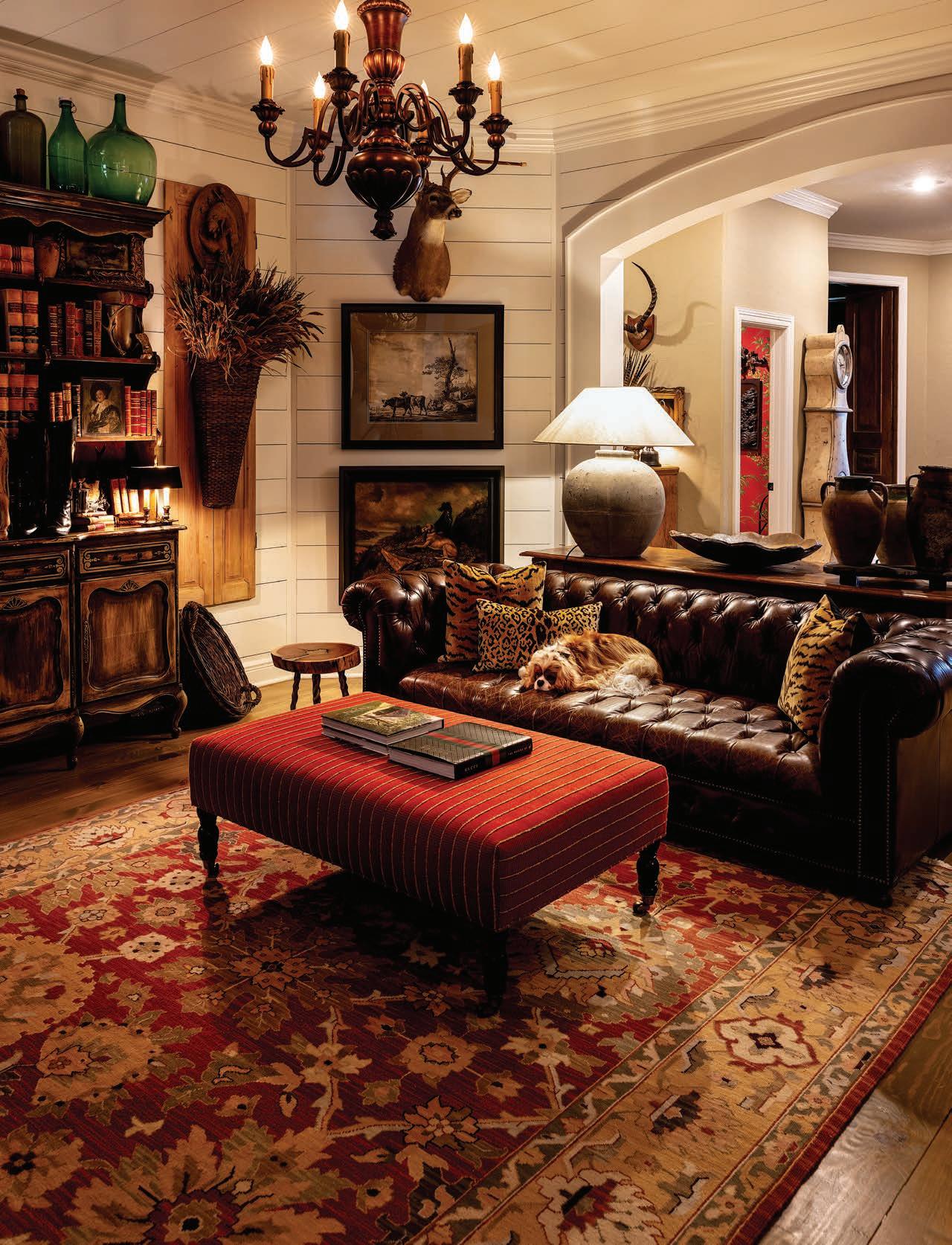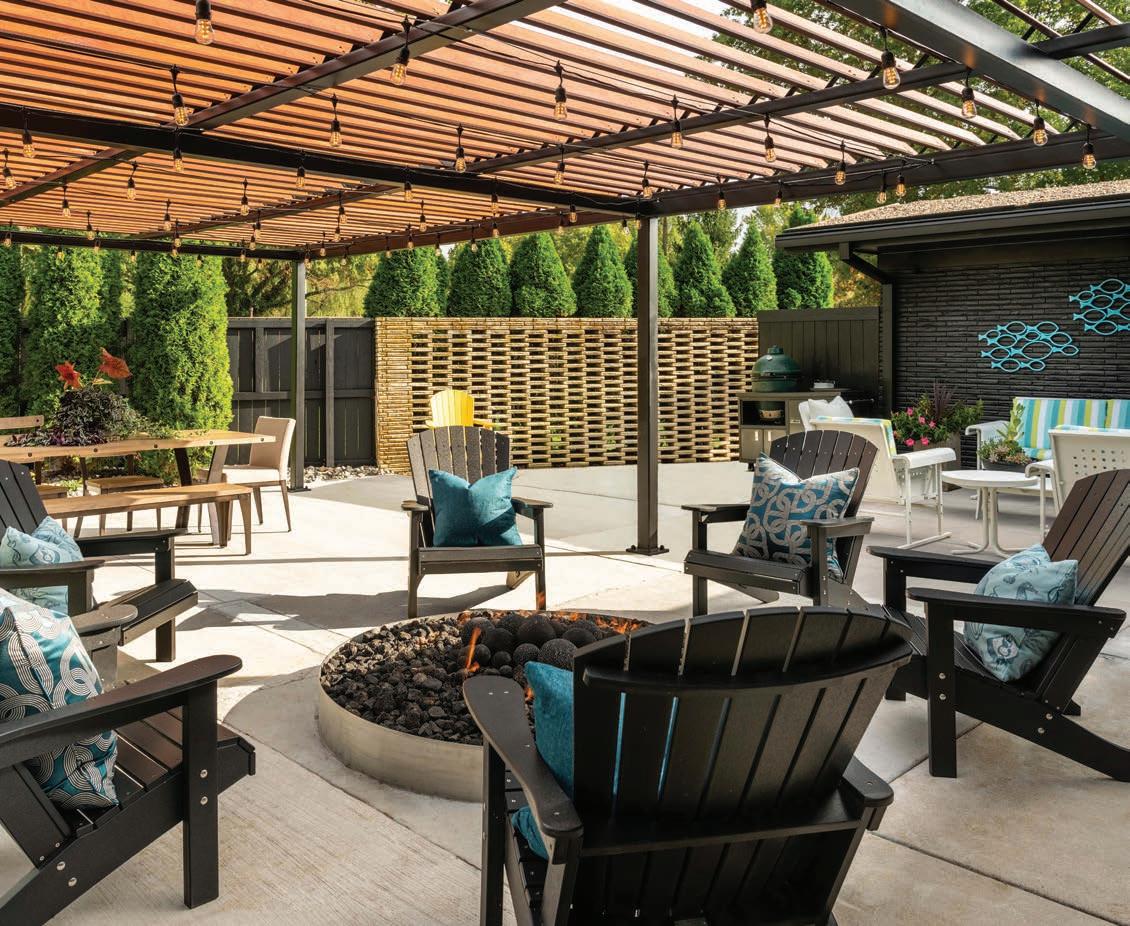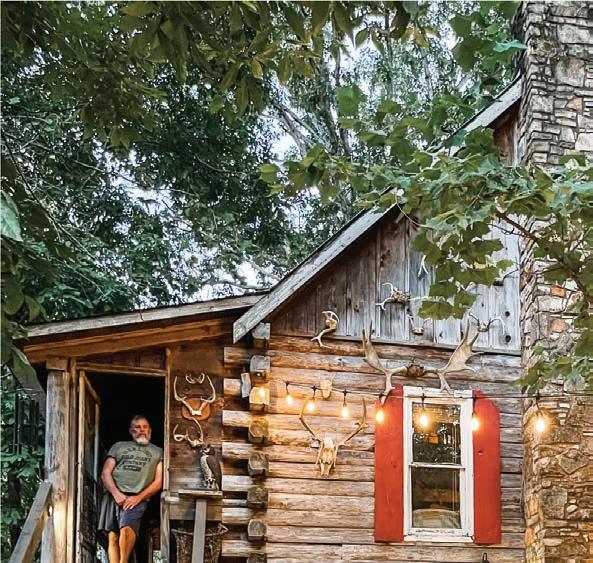
20 minute read
ESSAY
from 417 Home | Fall 2022
by 417 Magazine
FINDING BURIED TREASURE
When digging for a privacy fence in the yard of their Victorian-era home, Tessa and Chandler Cooper found a pile of ornate pottery shards that date back to the 1900s.
WRITTEN BY TESSA COOPER
When it comes to saving old homes, people have told me the right house nds you. I certainly believe that’s the case for our 1886 Victorian home in Spring eld’s Midtown historic district. I’d also like to think the fascinating discovery we came across in the backyard found us too.
While house shopping in 2020, my husband, Chandler, and I often went on walks and drives in our favorite neighborhoods. On one of our strolls in Midtown, Chandler saw our future home with chipped paint and missing windows and said, “What if we bought that?” It wasn’t even for sale, but its traces of Eastlake hardware, ornate wood front door and charming original Queen Anne stained glass had already won us over. These little details also made the hard work of restoration that would surely lie ahead seem well worth it.
I messaged a friend who lived nearby to ask about the home. In a stroke of serendipitous luck, we discovered she was one of the owners. She and her husband bought the decaying house to save it, and they graciously let us begin nishing the good work they started.
Throughout the major renovation, so many people asked me if we had come across anything interesting hidden in the home. We honestly didn’t nd many noteworthy things inside since our friends already completed most of the demolition work. I even bought a metal detector to hunt for treasures before the drywall stage, but alas, it detected nothing but old square nails.
About seven months into the project, we started working on the yard. We contracted one of our friends to put up a privacy fence. We went through all the right steps to get permission to dig in our backyard, but our friend called us over to show us that he thought he had hit an old pipe.
I daringly tugged at the item in question and realized it was actually a shattered, old tea cup. I began pulling the pieces out, and each time I did, a new one appeared. Several of the pieces looked like they went together, like parts of a pink rose patterned


tea plate, matching glass shards with a luminescent shine, old amber glass bottle bits and even parts of a small porcelain doll made in Germany.
One piece has the date 1907 on it, so we are guessing that this pile may have come from around that time. It is an honor to learn more about the people who once lived in our house through this little time capsule. These pieces reveal their interests and their favorite colors. I imagine how sad the former adorer of these objects must have been when they perhaps crashed on the oors of our very house. We already have grand plans for making a mosaic with these pieces, and I know there are still more shards in the backyard to discover.
We have some theories about why there are so many lovely pieces of pottery in our yard. It could have simply been a trash pile from days before garbage pickup services. I also read that European settlers often used shards of broken pottery to act as a drainage compost in clay-like soil, and the rst owner of our home was a Swiss-French immigrant. It may always be a mystery how the treasure trove got there, but I nd beauty in that. I am thankful this house and this buried treasure found us.
MORE
ollow along with the oopers’ restoration progress by following @tessajcooper on Instagram.


THE HOMES OF JONES SPRING
Although it’s commonly referred to as Jones Spring, the of cial name—and boundary for that matter—of the enchanting east Spring eld neighborhood changes depending on who you ask. And the same can be said for the neighborhood’s history. Each resident provides similar yet slightly altered versions of the same stories—and that just adds to the charm. From Civil War campsites and the forgotten town of Mumford to Laura Ingalls Wilder passing through on her way to Mans eld, the tales surrounding Jones Spring are as wild and winding as the waterway for which it’s named. And for those living on the banks of Jones Spring (and its neighborhood counterpart, Pearson Creek), the waterways are the central arteries—connecting the secluded set of homes with one common pulse. Over the train tracks and down the winding roads, we’re taking you inside one of 417-land’s most alluring yet allusive locales. Welcome to the Homes of Jones Spring—you’re going to want to stay a while.
WRITTEN BY COLIN SHEA DENNISTON | PHOTOGRAPHED BY BRANDON ALMS
IN THE BEGINNING
As a resident of Jones Spring for over three decades, Merrill Drummond’s connection to the neighborhood dates back even further—when a dirt road connected Jones Spring to Oak Grove and the neighborhood was in what she calls, “the sticks.”
Sitting on a plush sofa in her peacefully quiet Jones pring home the absolute definition of a pristine, midcentury charmer—Merrill Drummond reads from an old, onl slightl worn newspaper clipping. “’ ifteen miles from cit hall, Jones pring is a green wilderness through which a spar ling broo bubbles from an ic spring.’ ou re going to love all this stuff,” she adds with a mischievous grin. he continues reading, eventuall circling bac to the spring, which “’was once used b ivil War traders to power a mill and distiller . The old roc wall, which supported the flume of water, still stands li e a forgotten monument to da s that are long gone with the wind.’ nd that’s this wall down here,” she inter ects, pointing outside her wall of windows and down to Jones pring below. rummond, who lives in the home with her husband, ill, is the niece of ar orie a er ite, who, with John . Woodside and a couple of others, purchased acres of land from the sh rove imestone ompan in the earl s and eventuall platted and built on the neighborhood we now call Jones Spring.
“ aunt built this house,” sa s errill, who has been in the home now for more than ears. The rummonds perfectly content living in center city—learned that after her aunt’s death, the ban ’s trust department had put the house up for sale, and an interested bu er was considering tearing it down. “I ll admit it, it was an emotional thing for me,” sa s errill. “ nce I heard tear down,’ I thought, I can t let that happen.” That emotional tug was enough for the rummonds to put in an offer, leave center cit and move into the home Merrill visited as a child. ow, as longtime residents of Jones pring, the rummonds who are more than well versed in the neighborhood’s fol lore point out that its reach extends far be ond -land. “We came home one time and there was a tour bus here, and there was a group of oung Japanese women from To o,” recalls ill. “ nd the tour guide told us that the were following the route of one of aura Ingalls Wilder’s stories leaving pringfield and this is where the spent the night and that these oung women were in a aura Ingalls Wilder lub in To o.”
Even with the tour groups, the old public records, historical pla ues and faded documents passed down from one owner to the next, li e its canop of mature trees, a shroud of m stery continues to hang over the Jones Spring neighborhood. “If ou tal to ever bod who lives out here,” sa s ill. “I thin ou’ll get a slightl different histor .”


E T E TE T I “With all of the barn doors open and a fire pit roaring outside, it’s the perfect area to have a part ,” sa s Ferguson of the party barn.

THE GATHERING PLACE
Driving east down Catalpa—over the railroad tracks as it turns into Farm Road 144—it’s easy to miss Mindy Ferguson’s house. Even if you—and your GPS—are on the lookout. “When I’m telling friends how to get here, they’re like, ‘Oh my gosh I never even realized your house was here,’” Ferguson laughs.
While she now appreciates the home’s secluded location and hidden entrance—set back o the road and nestled behind an old schoolhouse-style Methodist church—it wasn’t necessarily love at rst sight. “At rst, I didn’t like [it],” says Ferguson. “But now I love the privacy… Because nobody knows it’s here.”
Beyond the church’s parking lot and down a long private driveway sits Ferguson’s stately home, which she describes as “Craftsman meets New England.” The home sits on over 11 acres with direct access to Pearson Creek running the full length of her property, so it’s easy to see why she was eventually taken by the location. “It’s in the city but it feels like you’re in the country,” Ferguson says. “The terrain—it kind of brings you back in time... A more simple life even though you’re still in 2022.”
Originally built in 1987, the earliest version of the home was far from the grand family home— painted in a rich dark tone—that now sits on the property. “It was just a little white farmhouse,” says Ferguson. “And they did another phase to it—built the barn in front, and the next owners built onto it and then I built onto it, so it’s been built onto three times.”
Ferguson moved into her Jones Spring home in 2020, right before the start of the COVID-19 pandemic. With lockdowns and stay-at-home orders in full e ect, Ferguson and her family were “so grateful to have this paradise of space and land during that time period.” Although Ferguson is currently in the process of moving into another home, she isn’t going far. “I wasn’t going to move unless there was something in this neighborhood that I loved,” she says. When Ferguson walked through her neighbors’ house as it was undergoing renovations—she knew it was the right move. “It just t me perfectly,” Ferguson says. “It just all fell in line. I didn’t want to leave the neighborhood; otherwise, I’d be keeping the house.”
And for the home’s next owners (and her future neighbors), Ferguson hopes to forge a friendship, continuing the home’s tradition as the uno cial neighborhood gathering spot. Ferguson and her neighbors regularly meet at the home’s fencepost with glasses of wine or beer in tow. “Mostly beer,” Ferguson says with a chuckle.
ET THE HI E I With large floor-to-ceiling windows, the home’s charming entr hallwa s welcome visitors inside with an abundance of warm, natural light. THE T P ore than ust an ideal spot for imaginative iddos, the bac ard treehouse offers a great bird’s-e e view of Pearson ree below.




E EE IEW The home’s main living space includes an expansive view of the bac ard and Pearson ree , while also off ering sightlines into the itchen and front hallwa .
THE PE E T P I I risp white cabinetr and a herringbone bac splash are complemented b the warm, rustic wood on the ceiling and fl oor enhancing the home’s craftsman-meets ew-England aesthetic.
Photos b T Photographer Photos by BR Photography “THE TERRAIN—IT KIND OF BRINGS YOU BACK IN TIME."


T H T ITI While the overall design leans heavil toward modern, the occasional traditional elements li e the large wrap around porch—can be found throughout the home’s design.






















W TE E T E ut-of-town visitors often assume that the front yard spring was added during the home’s construction. “We didn’t touch that,” had organ laughs. “That came with it. That’s as is.”
THE HOME UPSTREAM
Walking through the Morgan family’s spacious and light lled modern home overlooking Jones Spring is like getting a rst-rate lesson in geology and architecture— and it’s that way by design. “It was really important for us to focus on water,” says Chad Morgan. Before eventually being changed to Streamline House by architect Matthew Hu t, the home was originally named Alluvial, referring to a natural occurrence called an alluvial fan—usually created as owing water runs down a mountain, hill or canyon before spreading out into a fan-like shape. “That informed the decision that the house should be sort of modulated by the water,” says Morgan. “The concept is that pieces of the house were together, and then, like that alluvial fan, broken apart by water ow.”
Though relatively unnoticeable once inside the house, a bird’s-eye view of the home’s structure shows three seemingly disconnected units, conceptually detached by years of water ow: the garage area—separated by a dry riverbed leading to the front yard spring, the central structure, and the primary bedroom wing, which, although on the same foundation, appears independent. “You’re supposed to be standing here—in architectural terms— feeling as if you’re on a bridge,” says Morgan, standing in the home’s main entryway. With oor-to-ceiling windows and open stair slats, the light- lled room draws the vibrant, natural landscape in— giving those inside the feeling of oating right over Jones Spring.
When they moved to Spring eld 15 years ago, the Morgans were immediately drawn to the neighborhood they now call home. After purchasing the property in 2018, they tore down the existing 1970s home—with dark wood, small windows and a limited connection to its natural surroundings—and started fresh. And the fact that Jones Spring runs directly through the front yard was an added appeal for the family, whose beloved lake house sits on the shores of Table Rock Lake. “The ability to live on a body of water that connected us to our lake house—I just thought that was really pretty awesome,” says Morgan. “Literally this water goes to the lake house. You could e ectively do the message in a bottle thing, and it should, in concept, show up at that lake.”
Stunning as the home is, it’s the neighborhood, the surroundings and the spring that are the heart of the property. “There’s a lot of times that I pull onto the bridge and just stop,” says Chad’s wife, Kelly. “I’m not looking at the house. I’m looking at the landscape, the stream and outside.” Or as Chad puts it, “I’ve always thought your house is like a vehicle. You should be in the car, experiencing what is outside.”


W E W The fl oor-to-ceiling windows in the living space are, in fact, multi-slide doors ta ing indoor/outdoor living to the next level.
— CHAD MORGAN

P s an homage to the famil ’s la e house which has a wooden rendering of Table oc a e the itchen ceiling features a custom made, etted metal rendering of Jones pring.
I or added privac , the itchen and main living area run along the bac side of the house. “I’ve heard man times people sa , ou gu s are never home,’” sa s had organ. “That’s ind of the tric of architecture how to get lots of natural lighting in but not feel li e ou’re living in a fi shbowl.” WIDE RULED Wide plank white oak fl oors add Scandinavian simplicity to the dining room design.

THE E T The home was originall built as a single-story structure. The second level was added on b previous owners in the earl s.

THE HOUSE BUILT WITH HISTORY
For Ben Jacobs, Spring eld, Missouri, is an ideal city. “The town itself is probably the perfect size—it’s not too big, it’s not too small, it has everything you need,” says Jacobs. Ben, along with his wife, Betsy, and two sons, moved back to Spring eld in 2018 after spending years in a variety of larger cities around the country like Redding, California, and Austin, Texas. The Jacobs family lives in an utterly charming cottage-style home—uniquely situated on the banks of Pearson reek and within walking distance of its convergence with Jones Spring.
“This area speci cally—it’s really quiet,” says Ben. “We’re just on the edge of Spring eld, but it kind of feels like you’re farther out than you are.”
“Honestly,” adds Betsy, “it’s just wild because we’ll be sitting here and you’ll have these huge birds y in in the morning and deer with their babies walking in the creek.” And that’s just during daylight hours. “The whole vibe at night is beautiful,” she adds. “You can see the creek and at night you can hear it going by—it’s just so nice.”
And while the Jacobs were initially drawn to the home’s one-of-a-kind design style and serene setting, they quickly became immersed in the neighborhood’s mystical charm and historical folklore. “There’s just history here, and I think you can connect to and feel it,” says Betsy. “I felt it immediately when we walked in the house to see it.”
Ben even recalls hearing that the land surrounding their home was used as campgrounds during the Civil War. According to the story, Union soldiers camped on the banks of Pearson Creek on their way to Wilson’s Creek. “And I think that makes sense,” says Ben. “Because a lot of the guys out here with metal detectors will nd buttons or coins from that era. Someone actually saw a bullet—like a spent bullet—one of those little musket balls.”
Even the home itself, which was completed during the late 1970s, is—down to its foundation— full of history. “On the exterior it has this New England, cottage type of vibe, but inside, everything you’re looking at has been reclaimed and restored,” says Betsy. “Literally every piece of wood in this house.” And what they’ve now transformed into an outdoor re pit overlooking the creek was initially a pile of brick left over from the home’s construction. “That brick came from Co eeville,” says Betsy. “You can look at it and it has all the Co eeville stamps from Kansas where they made it.”
Since honoring the home’s history is a top priority, the Jacobs are hesitant to make any dramatic interior changes. But the backyard, with its freshly updated re pit, has become one of their favorite locations to soak in the sights and sounds of nature. “You would have to come out and hang out at that re pit when the sun’s setting,” says Betsy. “It’s so quiet and you can hear the creek going.”
“And then Ben’s always in that hammock,” she adds laughingly. To which he quickly replies, “I am!”

I I E TE I Designed by noted 417-land architect on ussell, the exterior features sha e shingles and stonewor often found on Russell-built homes of the same era.
— BETSY JACOBS


I -W T HI The home’s serene bac ard is often visited b a wide variet of feathered friends. “ wls, ospre s, cranes all these incredible weird little creatures,” sa s ets Jacobs.
WITH IEW sitting area b the ba windows off ers unobstructed views of nearb nature. “I ust li e that at an point I can see outside,” sa s Jacobs. “It reall does feel li e the outside’s inside.”
IE While future plans include updating the home’s roof and s light, there was one change to the itchen that had to happened upon move in “There used to be a hanging, fl oating shelf for dishes, sa s Jacobs. “I said, That’s the onl thing that has to come down immediatel .’”




H TE H The home’s salvaged histor is displa ed in the staircase, where a reclaimed wood beam is met with a custom iron railing.
Rather than altering the home’s original design, Jacobs personali ed the space with eclectic furniture and one-ofa- ind art.






DESIGN AWARDS
BEST OUTDOOR SPACE P.51 BEST USE OF COLOR P.54 BEST LAUNDRY ROOM OR MUDROOM P.56

54
COLOR CODE Pops of citron fabric mix with a high-gloss rich navy paint color to give this winning space a double dose of drama. Read more on p. 54.

available through: solutions for:


•dealers •designers •architects

showroom exclusive to the trade •residential •commercial •hospitality
1364 n. kelly ave nixa, mo 417.725.5515 mon-fri 8-5 or by appointment uniquetile.com











